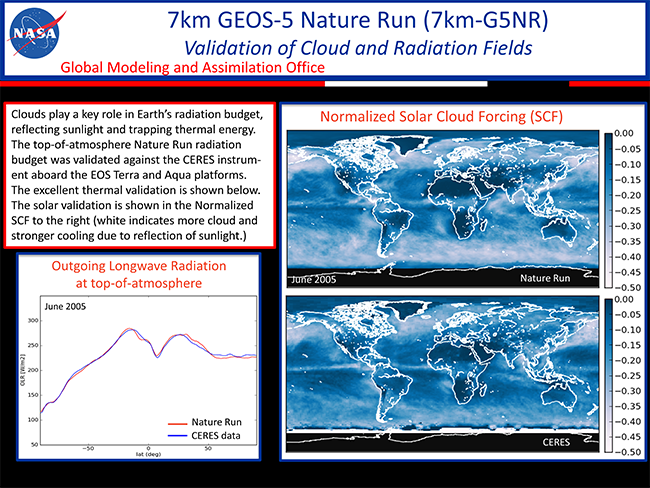7km GEOS-5 Nature Run Validation of Cloud and Radiation Fields
OLR: The Outgoing Longwave Radiation simulated in the Nature Run is in excellent agreement with the observed estimate from the CERES experiment. The zonal averages (bottom left) show agreement to within a few Wm-2 at all latitudes, with a very successful representation of the NH summer/SH winter energy balance, with the double tropical maxima and a local minimum near the Equator.
Normalized SCF: For the Normalized Solar Cloud forcing, white indicates the regions where the presence of clouds leads to a cooling of the atmosphere compared to what would happen in the absence of clouds. More cloud cover leads to more reflection (back to space) of incoming sunlight, thus reducing the amount of sunlight absorbed in these regions. There is very good general agreement between the Nature Run and the CERES observations:
- (1). A slightly reduced Hadley cycle intensity in the model, evidenced by slightly weaker Inter-Tropical Convergence Zone (ITCZ) cloudiness along Equator (more diffuse, less bright) and slightly weaker subtropical subsidence zone cloud minima. For example, the very low (dark blue) values in clear sky regions (NW Pacific, S Pacific, S Indian Ocean subtropics) in the CERES data are not as pronounced in the simulation;
- (2). The Southern Ocean storm track cloud is somewhat too bright in the model;
- (3). West-coast stratocumulus has a near-coast clear swath in the model (e.g., Southern California, likely due to a weaker temperature inversion).
Note that these are not just issues with the GEOS-5 Nature Run: they are long-standing issues seen in many global models. Further improvements in clouds and boundary layer physics and increases in resolution in horizontal and vertical are necessary to address these problems. GMAO researchers are making improvements in these areas, by introducing. GMAO is making progress in improving these areas by introducing more complex physical mechanisms (such as cloud microphysical properties) and further increasing resolution.


